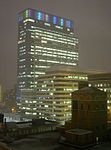Peavey Plaza
Brutalist architecture in MinnesotaBuildings and structures in MinneapolisEvent venues established in 1975Event venues on the National Register of Historic Places in MinnesotaHistoric American Landscapes Survey in Minnesota ... and 4 more
Modernist architecture in MinnesotaNational Register of Historic Places in MinneapolisPublic art in the United StatesTourist attractions in Minneapolis

Peavey Plaza is a public outdoor event space in downtown Minneapolis, Minnesota at the south end of Nicollet Mall between South 11th and 12th Streets. The sunken plaza and its amphitheater were designed by landscape architect M. Paul Friedberg and built in 1975 alongside Orchestra Hall. The Cultural Landscape Foundation has deemed the plaza a "marvel of modernism" and it has been named one of the top ten most endangered historical sites in Minnesota.
Excerpt from the Wikipedia article Peavey Plaza (License: CC BY-SA 3.0, Authors, Images).Peavey Plaza
Nicollet Mall, Minneapolis
Geographical coordinates (GPS) Address Phone number Website Nearby Places Show on map
Geographical coordinates (GPS)
| Latitude | Longitude |
|---|---|
| N 44.972194444444 ° | E -93.275527777778 ° |
Address
Orchestra Hall
Nicollet Mall 1111
55402 Minneapolis
Minnesota, United States
Open on Google Maps








